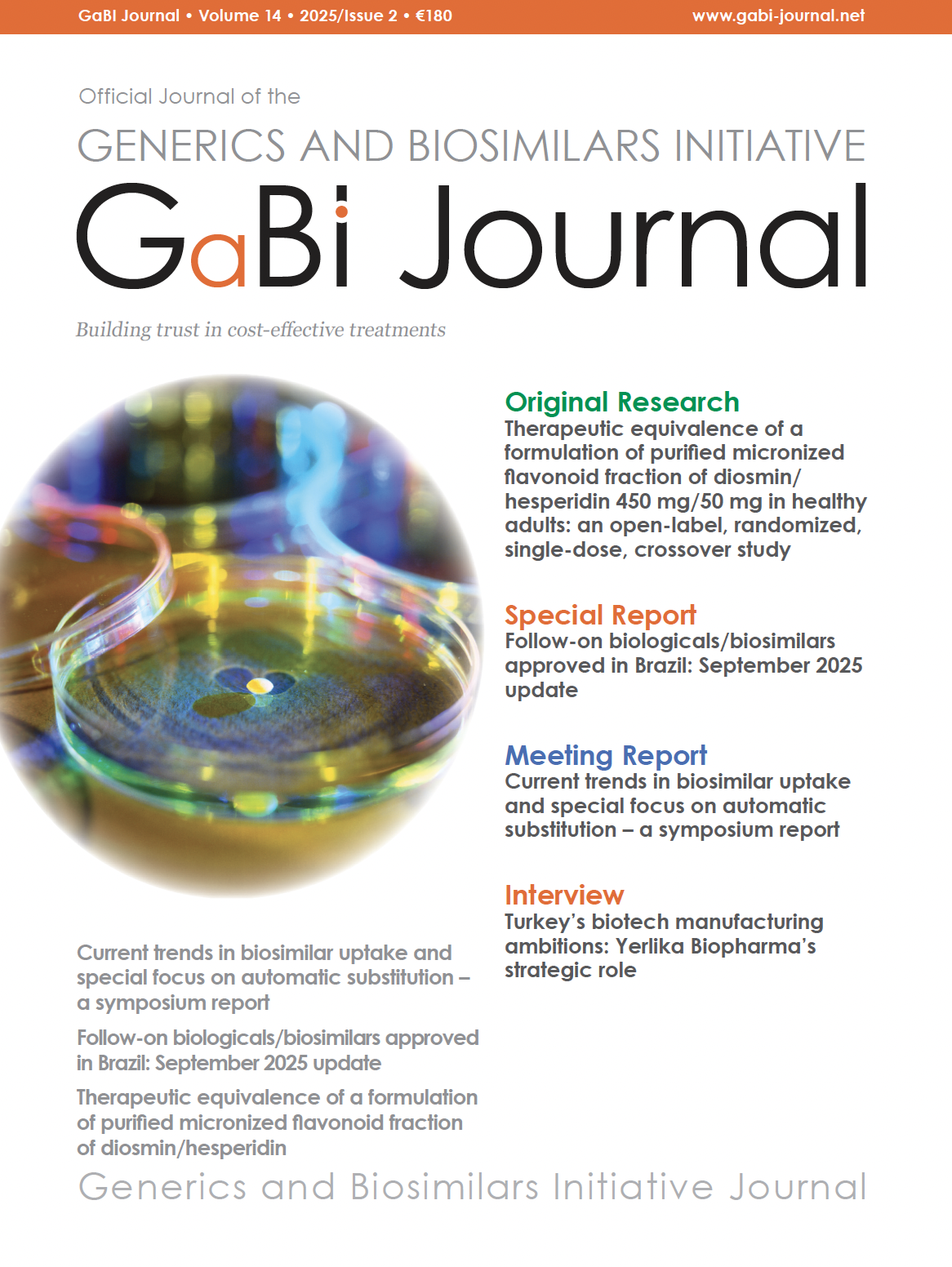Fourth and final issue of GaBI Journal’s third volume
Published on 2014/12/17
Generics and Biosimilars Initiative Journal (GaBI Journal). 2014;3(4):161.
The interest in the development, regulatory approval, use, and post-marketing surveillance of generic and biosimilar pharmaceutical products continues to increase; as illustrated by the tremendous number of views (over 1,028,324 since 2012) of articles published in the GaBI Journal.
I expect that this interest will continue to increase after publication of this fourth and final issue of 2014. This issue begins with an Editorial by Dr Brian Godman, a member of our International Editorial Advisory Board, discussing the Original Research paper by Vogler et al. reporting the results of a survey done on the availability and procurement of five selected cardiovascular products in a small number of hospitals in five European countries. These two manuscripts discuss some of the barriers remaining to the more widespread use of well-characterized generic drug products even in European Union countries with access to well-characterized products including the need pointed out by Dr Godman for ambulatory and hospital inpatient sectors ‘to work more closely together to maximize the health gain of patients’.
Additional barriers exist in countries where access to modern regulatory methods and to well-characterized follow-on products are both limited. Professor Cheraghali from Iran proposes in his Letter to the Editor that countries with limited ability to completely evaluate such products should allow ‘limited marketing’ of follow-on biological products under the (undefined) ‘direct surveillance of regulatory authorities’. Regulators in many countries definitely face difficulties in adequately evaluating such products and there are clearly potential (even if poorly documented) benefits to providing patients access to them. However, there are also clear risks. Both process details and actual data on risks and benefits are needed before such a suggestion can be adequately evaluated. We welcome comments on this suggestion from our readers.
In a Review Article Drs TJ Giezen and CK Schneider discuss the importance of product quality and safety assessments of biosimialrs for the extrapolation of indications, as well as the issues of traceability and interchangeability of such products from the perspective of European regulators. The issues raised by this paper illustrate how difficult it is to inadequately evaluate follow-on products even with adequate regulatory resources. The issues raised by these regulators suggest, at least to me, that the process proposed by Professor Cheraghali is unlikely to ensure product quality and patient safety. Of note, in a Regulatory paper Ms Arpah Abas and co-authors suggest that the use of partnerships between countries is an alternative solution to the problems associated with regulating in a resource poor environment such as Malaysia.
In a Commentary, Dr René Anour discusses the use of biosimilars versus ‘biobetters’, i.e. follow-on biological products that without being structurally based on each other; share the same target. He suggests that from a regulator’s perspective the safe use of such products ‘depends on their interchangeability’ and concludes that ‘regulatory guidance will … have to evolve, to keep biosimilars competitive against biobetters and avoid pitfalls in their development’.
In an Opinion paper, Dr David Lim presents why he believes Australia is particularly well positioned to become a leader in the biosimilar field; including its relationships with Asian countries, pricing policies, and laws that limit what can be patented. In a second Opinion paper authors from the European Biopharmaceutical Enterprises (EBE) group (all of whom work for pharmaceutical firms) present their argument for providing more detailed, transparent labelling of both originator and follow-on products to make clear what information came from studies done with follow-on versus originator products.
In a related Pharma News paper one of our GaBI Journal editors, Dr Bea Perks, reviews the ‘toolkit’ developed by the International Alliance of Patients’ Organizations (IAPO) to educate patients and patient organizations about biological and biosimilar medications. The Journal welcomes manuscripts from such patient advocacy groups. It would be especially useful if these groups (or others) presented some actual data demonstrating how labelling or the use of the proposed toolkit improves the efficacy, safety or even the acceptability of such products.
A Pharma News paper by Dr Michelle Derbyshire, another of our editors, abstracts some data on the limited savings produced from the use of generic and biosimilar medicinal products in Europe and in an Abstracted Scientific Content paper our GaBI Journal editor Dr Bea Perks reviews a publication by Leopold et al. from Austria discussing ‘pharmaceutical policy interventions in times of economic recession’ that presents data on the use of generic antipsychotic drugs in Finland and Portugal. Dr Leopold’s publication highlights the potential differences between short- and long-term effects of policy measures and suggests that beneficial short-term effects of cost-sharing might also have unintended negative long-term effects, especially in the most economically challenged populations. I would like to encourage submission of manuscripts providing data comparing the long- versus short-term effects of public policies since they could be of great interest to our readers.
In an Interview with GaBI, Amgen gives an insight on how it intends to gain market share with its biosimilars. The biotech giant believes in encouraging, not forcing, the use of biosimilars and that by emphasizing the quality of its products physicians and patients will choose to use biosimilars. As evidence of how this approach can work the example of a Japanese erythropoietin biosimilar is given.
Finally, I would like to thank all our authors, readers, reviewers, our publisher and our entire editorial staff for all their hard work and to wish all of you a happy, healthy holiday season and coming New Year.
Professor Philip D Walson, MD
Editor-in-Chief, GaBI Journal
Disclosure of Conflict of Interest Statement is available upon request.
Copyright © 2015 Pro Pharma Communications International
Permission granted to reproduce for personal and non-commercial use only. All other reproduction, copy or reprinting of all or part of any ‘Content’ found on this website is strictly prohibited without the prior consent of the publisher. Contact the publisher to obtain permission before redistributing.


